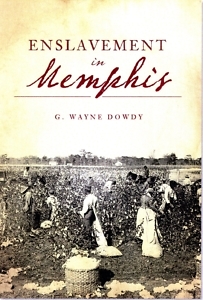Lifting the Veil on Slavery
Wayne Dowdy documents the history of enslaved African Americans in Memphis
Whenever one of my graduate students is beginning a research project about Memphis history, I always start with the same advice: Go see Wayne Dowdy. As senior manager of the Memphis Public Library’s history department, Dowdy knows all the archival material that tells the story of the city. He is an accomplished author in his own right, with a reputation for careful research and clear prose. His latest book is Enslavement in Memphis, a short history of slavery’s growth, demise, and legacy in the Bluff City.
 Dowdy is a contributing writer for Best Times magazine and Storyboard Memphis. His previous books include Mayor Crump Don’t Like It: Machine Politics in Memphis, A Brief History of Memphis, Lost Restaurants of Memphis, and On This Day in Memphis History. He answered questions via email from Chapter 16.
Dowdy is a contributing writer for Best Times magazine and Storyboard Memphis. His previous books include Mayor Crump Don’t Like It: Machine Politics in Memphis, A Brief History of Memphis, Lost Restaurants of Memphis, and On This Day in Memphis History. He answered questions via email from Chapter 16.
Chapter 16: How did slavery shape the economy and culture of Memphis in the era prior to the Civil War? Did the institution of slavery change over this time?
Wayne Dowdy: For the first 25 years of its existence, Memphis was rather conflicted over slavery. When the city was founded in 1819, there was very little economic activity, and as a result the need for enslaved people was quite small. In the 1820s and 1830s, some Memphians supported the efforts of Scottish reformer Frances Wright in her plan to gradually emancipate slaves, and they sent an anti-slavery delegate to the 1834 Tennessee Constitutional Convention. However, the growth of the cotton economy in West Tennessee thwarted all attempts to free the enslaved in Memphis. In 1830, for example, 1,000 bales of cotton worth $3,500 passed through Memphis. Ten years later that number had grown to 35,000 bales valued at $1,400,000. The need for more slave labor to handle this increase in cotton production led to the development of a slave trading industry which, as horrible as it sounds, also added value to the economy of Memphis.
Chapter 16: In the appendix, you list all the enslaved African Americans in Memphis who are in our archival records. It is striking to see the scope of slavery in the city. But it also suggests how little historical detail we have about most individuals. As a historian, how can we compensate for this lack of information? Can we render slaves in their full humanity?
Dowdy: I wrote this book specifically to emphasize that slaves were human beings trapped in an inhuman system. Too often, books about slavery end up being more about white owners than about slaves, as if African Americans were incidental to their own story. It is incumbent on those of us who study the past to uncover those hidden stories buried within the primary sources. We need to think creatively about these sources so we can glean all the information available.
As an example, I used the congressional testimony given by those who witnessed the 1866 Memphis Massacre. Each African American who testified was asked if they had been a slave and when they were set free. Their answers allowed me to reconstruct parts of the lives of several former slaves. One of the most intriguing statements was that of Ann George, who was brought to Memphis two weeks before Christmas, 1865. When asked her age, she replied, “I don’t know. I have been a slave all my days until about six months ago.” Her statement was given in late May of 1866, so we can determine that she was freed at the end of December 1865 or in January 1866. The congressional report that was written from this testimony was not created to document the lives of slaves, so this detail could easily be overlooked. This is what I mean by thinking creatively.
Chapter 16: Nathan Bedford Forrest stood at the center of a recent local controversy. In 2018, his statue in a Midtown park came down, and this summer, his grave was moved, as well. What does Enslavement in Memphis say about Forrest? What was his role in the city’s history of racial exploitation?
 Dowdy: Forrest is central to Memphis’s development as a major slave trading center in the 1850s. His firm was larger than anyone else’s, and it was the wealthiest, raking in $96,000 per year. His slave yard was located on Adams Street, next door to Calvary Episcopal Church. There is no better symbol of the cruelty and indifference that most white Memphians felt toward African Americans than that of Forrest’s slave jail thriving next to a prominent house of worship. Forrest was also an unscrupulous businessman and politician. In 1859, he bought and sold into slavery 37 Africans from the Congo who were illegally imported into the United States. That same year he also used his influence as a city council member to increase the cost of business licenses, which forced one of his rivals to close their doors.
Dowdy: Forrest is central to Memphis’s development as a major slave trading center in the 1850s. His firm was larger than anyone else’s, and it was the wealthiest, raking in $96,000 per year. His slave yard was located on Adams Street, next door to Calvary Episcopal Church. There is no better symbol of the cruelty and indifference that most white Memphians felt toward African Americans than that of Forrest’s slave jail thriving next to a prominent house of worship. Forrest was also an unscrupulous businessman and politician. In 1859, he bought and sold into slavery 37 Africans from the Congo who were illegally imported into the United States. That same year he also used his influence as a city council member to increase the cost of business licenses, which forced one of his rivals to close their doors.
Chapter 16: Memphis spent most of the Civil War under the occupation of the Union Army. How did that shape the status of slavery in the city? Did it shape the process of emancipation?
Dowdy: The Union occupation of Memphis altered the institution of slavery and laid the foundation for its ultimate extinction. There was confusion within the federal officer corps on how to handle slavery when the Union occupied Memphis in June 1862. Congress had passed the Confiscation Act, which allowed for the seizure of slaves to deny their labor to the rebels. President Abraham Lincoln, however, ordered the Army not to interfere with the institution. Meanwhile, slaves from the surrounding area poured into Memphis, forcing Union commanders to deal with the situation. Headquartered in Memphis, General U.S. Grant ordered runaway slaves, euphemistically known as contrabands, to work fortifying the south end of the city. In mid-July 1862, Congress passed the Second Confiscation Act, which declared that all slaves owned by rebel civilian and military officials were free. Ultimately, it was the presence of the Union Army that provided the opportunity for thousands of slaves to free themselves.
Chapter 16: What are the legacies of slavery in Memphis history? How has the public memory of slavery changed over time?
Dowdy: It may be too easy to blame the existence of systemic poverty on the legacy of slavery, but I suspect that for many Black families, there is some truth in this assessment. In the final chapter, I trace what happened to many of the former slaves in post-emancipation Memphis. Skilled slaves helped lay the foundation for the Black middle class, while their unskilled brethren remained trapped in poverty.
As for memory, until very recently white Memphis has done all it could to erase, or at least obscure, the city’s role in enslaving human beings. There are reasons to be hopeful that the veil of historical ignorance is finally being lifted. I hope in a small way that Enslavement in Memphis will help in that lifting.

Aram Goudsouzian is the Bizot Family Professor of History at the University of Memphis. His most recent book is The Men and the Moment: The Election of 1968 and the Rise of Partisan Politics in America.





